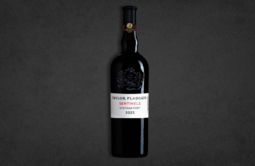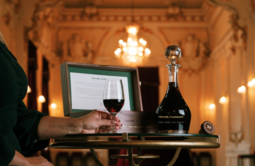Passing the Port
According to custom, Port is passed around the table in a clockwise direction. Each guest pours him or herself a glass and then hands the decanter or bottle to the person seated to the left. The tradition is designed to ensure that everyone has the opportunity to enjoy the Port. The clockwise direction is due to the fact that most people are right handed. See also 'Hoggit' and 'Bishop of Norwich'.
Patamar
A patamar is a modern vineyard terrace. As opposed to the traditional historic walled terraces on which the oldest Port vineyards are planted, patamares are not supported by dry stone walls. They are constructed using earth moving equipment and are separated by tall earth banks. Patamares were constructed extensively in the 1970s and 80s throughout the Douro Valley. However today many of these are being replaced with planting in vertical rows, running perpendicularly up the hillsides, a technique known as vinha ao alto. Vinha ao alto has several environmental and quality advantages over patamares but can only be carried out on hillsides with gradients of up to about 30%. On Taylor's estates, many original patamares are being replaced with very precisely engineered terraces which are part of a sustainable vineyard model developed by the firm's viticulture team.
Phylloxera
In the late 1850s and early 1860s it was common for botanists and vine growers to import native North American vines into Europe. They were not aware that, in many cases, these American vines carried with them small yellow mites which fed on their roots, sucking their sap. The American vines were accustomed to the assaults of these barely visible parasites and had developed ways to survive them. However the European wine-producing vines had no defenses. The mites would insert their feeding tubes into the vine root, causing tuberous swellings until the root was so deformed that it could no longer draw water or nutrients from the soil. Starved and parched, the vine withered and died. The first serious attack occurred in the southern Rhône in 1862 and the pest then spread rapidly to other parts of France causing widespread devastation to the vineyards. When the cause was finally identified, the destructive louse was named Phylloxera vastatrix (meaning 'the dry leaf devastator'). Phylloxera is believed to have reached the Douro Valley in 1868. It first unleashed its destruction on the eastern area of the Douro, the source of the finest Ports, and by 1872 had brought many famous Port estates to their knees. Yields fell dramatically, causing shortages of wine and a rise in prices. One of the most energetic champions of the battle against Phylloxera was John Fladgate, one of the partners of Taylor's, who was awarded the title of Baron of Roêda for his work in combating the blight. It was some time, however, before the solution was found. This was to graft the European wine-producing vines onto the resistant roots of native American varieties, a measure which eventually put a stop to the destruction.
Pipe
Today a pipe is simply a unit of liquid volume equivalent to 550 litres. Port prodution is generally expressed in 'pipes'. Today all Port is shipped in bottle but in former times it was also shipped in bulk, in other words in a barrel or container. The barrels used to ship Port were known as pipes and their capacity was 534 litres. There were also smaller sizes representing fractions of a pipe,namely the hogshead (half pipe), quarter and octave. Wealthy individuals would sometimes order a 'pipe of Port' from their wine merchant, either for their own consumption or to 'lay down' as a gift to a young relative. A pipe was usually taken to be 60 dozen, or 720 bottles. A pipe should not be confused with a cask which is a larger type of barrel used for ageing. Casks are always made of oak but shipping pipes could be made either of oak or chestnut. See also 'Cask' and 'Traditional measures'.
Port glass
The main requirements of a Port glass are that it should be large enough to allow the enjoyment and appreciation of the wine's aromas and should be made of good quality glass. It is not essential to serve Port in a specific Port glass. A good quality white wine glass is a very good substitute. However there are excellent Port glasses available, including those made by the famous Austrian glass manufacturer, Riedel. Very small thimble-like 'Port glasses' or the concave glasses know as 'schooners' should never be used for Port as they are too small for the aromas of the wine to be enjoyed.
See also Port Glasses and Accessories
Port tongs
The cork in a very old bottle of Vintage Port can sometimes become soft and difficult to remove with a corkscrew. To avoid having to draw the cork, Port tongs are sometimes used to remove the top of the neck of the bottle. The tongs, whose pincers are designed to grip the neck of the bottle, are first heated to a very high temperature over a strong flame or in the embers of a fire. They are then clamped around the neck of the bottle for half a minute or so while they transmit their intense heat to the glass. As soon as the tongs are removed, a cold damp cloth is wrapped around the neck. The sharp change in temperature causes a clean break to occur in the glass, often with an audible ‘ping’, and the top of the neck separates from the bottle, cork and all. More often than not, Port tongs, which require some practice to use successfully, are used for show. In most cases even a ‘difficult’ cork on a very old bottle can be removed successfully with a corkscrew given some patience and care.
Port Wine Institute
Pre-Phylloxera
This expression refers to the era prior to the arrival of the American vine louse, Phylloxera vastatrix, which destroyed many of the vineyards of Europe in the 1860s and 70s. For example, a pre-Phylloxera wine is one produced from grapes grown before the arrival of phylloxera in the vineyard. A remarkable example of a pre-Phylloxera wine is the very rare Taylor's Scion Port. Phylloxera was eventually controlled by grafting the European wine-producing vines onto the Phylloxera-resistant roots of American vines. The term pre-Phylloxera is sometimes used loosely, and inaccurately, to describe vines which are not grafted but grow on their own roots as they did before the arrival of the pest in Europe. See also 'Phylloxera'.


discover more



